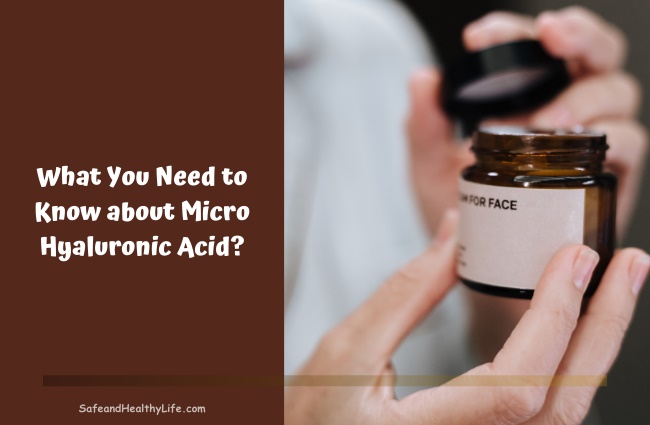What Is Hyaluronic Acid?
Hyaluronic Acid (abbreviated HA) or (C14H21NO11)n was discovered in the vitreous humor of the bovine eye by Karl Mayer and John Palmer in 1934. Its structure was later analyzed.
It is a disaccharide glycosaminoglycan composed of D-glucuronide and N-acetylglucosamine. Hyaluronic acid is part of the intercellular matrix of the human body and plays an important role in water retention and regulation of osmotic pressure.
Hyaluronic acid retains moisture and provides a protective barrier to the human body, especially the eyes, joints, and skin. It is a significant chemical used in many industries, especially the cosmetics industry.
What Is Micro Hyaluronic Acid?
Micro Hyaluronic Acid is a form of hyaluronic acid that is relatively small in size but more effective. It is a low molecular weight HA (<5,000 Da), even lower than mini HA (<10,000 Da).
As mentioned at the beginning, hyaluronic acid is a polymer. Hyaluronic acid has a large molecular size, which makes it difficult for it to penetrate the skin. However, small molecules can penetrate deep into the skin and promote cell proliferation and differentiation.
Therefore, small pieces such as micro hyaluronic acid penetrate the skin much more easily and have a better regenerating effect.
Micro-HA Super Active Hyaluronic Acid is a new small molecule active ingredient. It is made by our unique enzymatic decomposition technology and has excellent biological activity.
Micro HA retains moisture, protects the skin from inflammation and irritation, and penetrates the epidermis and dermis to scavenge free radicals. For more information on Micro HA and related quality products, please visit our homepage.
How Can I Get Micro Hyaluronic Acid?
There are three ways to get Micro Hyaluronic Acid. Here are their pros and cons.
- Animal source: This was the earliest method to obtain micro hyaluronic acid. However, it was abandoned due to its low extraction rate, huge cost, and complicated separation process.
- Industrial Synthesis: This is currently the most common method of obtaining micro hyaluronic acid. It can produce micro-hyaluronic acid quickly and efficiently.
- Microbial Fermentation: A new method to produce hyaluronic acid to replenish HA in the human body.
What Are the Advantages of Micro Hyaluronic Acid?
–Micro Hyaluronic Acid in Cosmetic Industry
Micro Hyaluronic Acid is widely used in cosmetics. From the first creams, lotions, essence capsules, and film pastes to bath liquids, powders, lipsticks, shampoos, and conditioners, the substance is used in a wide variety of products, providing beauty enthusiasts with an amazing user experience.
1. Hydration
The main benefit of Micro Hyaluronic Acid is hydration. Because micro hyaluronic acid contains numerous carboxyl and hydroxyl groups, it can bind a large amount of water and can absorb more than 1,000 times its weight in water.
In general, taking a small amount of micro-hyaluronic acid is equivalent to taking a large amount of water for your skin. In addition, it can continue to absorb moisture from the environment, providing long-lasting hydration to the skin.
2. Repair
Micro Hyaluronic Acid protects our bodies from harmful toxins every day. A variety of factors, from UV rays to pollution such as sudden temperature changes, can damage our skin, causing wrinkles, age spots, and an increase in dry skin.
Other harmful factors include over-cleansing, over-skin care, and over-makeup. Micro hyaluronic acid, on the other hand, promotes cell growth and facilitates the repair of this damage.
3. Protection
It also has preventive effects, thus regulating inflammatory factors, promoting cell proliferation and differentiation, and scavenging free radicals.
In the long term, it forms a complex network structure and acts as an excellent protective barrier for the skin.
4. Increases resistance
Micro Hyaluronic Acid has a very low molecular weight, so it easily penetrates the epidermis and dermis.
According to statistics, the absorption capacity of micro hyaluronic acid was 35.6 degrees after 0.5 hours, 52.5 degrees after 1 hour, 81.9 degrees after 8 hours, and over 90 degrees after 24 hours. Compared to comparable hyaluronic acid, micro hyaluronic acid is more protective.
–Micro Hyaluronic Acid in Other Industries
Micro Hyaluronic Acid is not just a substance used in skin care products. It is also used in the medical field and research.
- Used to treat knee osteoarthritis by intra-articular injection
- Used in the manufacture of artificial tears to treat dry eye
- Used in tissue engineering and regenerative medicine research due to its high biocompatibility
- Medical grade hyaluronic acid may be used in eye surgery such as cataract surgery, glaucoma surgery, and retinal detachment repair surgery.
Where Can I Buy the Best Micro Hyaluronic Acid?
Stanford Chemicals Company (SCC) is a wholesaler of pure organic hyaluronic acid in the United States. The company has extensive experience in manufacturing and marketing medical, cosmetic, and food-grade hyaluronic acid (HA).
We also offer high molecular weight, medium molecular weight, and low molecular weight hyaluronic acid powders. Please contact us for more information.
Micro Hyaluronic Acid Specifications
| Product name | Super Active Hyaluronic Acid |
| INCI Name | Hydrolyzed Sodium Hyaluronate |
| Molecular weight | <5k Da (average: 3k Da) |
| Appearance | Almost white or pale yellow powder |
| Recommended dosage | 0.05%-0.5% |
| Application | Soluble in water; Can be added directly to water |
About The Author:
Stacey Smith is a freelance health writer. She is passionate to write about women’s health, dental health, diabetes, endocrinology, and nutrition and provides in-depth features on the latest in health news for medical clinics and health magazines.





